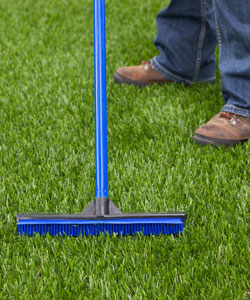

Keep it clean
For the majority of homeowners, a SYNLawn artificial turf installation is a considerable investment, and therefore requires a lot of care and maintenance to ensure that they get the most out of their lawn. As a result, take into account the following maintenance guidelines to help protect and care for your SYNLawn® synthetic grass products. This will extend the turf’s lifespan as well as keeping the area looking its absolute best at all times.
Consider the following advice to help you preserve and care for your turf, so it will look stunning for years to come.
DOWNLOAD CARE & MAINTENANCE .PDF
Dust, pollen, and airborne pollutants
Rainfall is the best faux turf cleanser, as well as the cheapest! However, if you live in an area where rain is a rarity, a quick spray with a water hose can eliminate dust or pollen that may be present.
For lightly soiled areas, a basic mixture of warm water with a 5% solution of a mild household detergent can work wonders! Simply sponge mop the affected spot and then rinse.
For areas that are more heavily soiled, use the above procedure before then sponge mopping the area with a 3% solution of household ammonia in hot water. When this has been completed, rinse the area thoroughly with warm water.
Stains and other blemishes
The most important element to remember is promptness, since it is infinitely easier to clean up a fresh spill than to remove a stubborn blemish once it has dried, hardened, and “set in.” Solid or paste-like deposits can be removed with a plastic table knife or spatula, while excess liquids can be blotted up with paper towels, a clean cloth, or a dry absorbent, such as kitty litter or fuller’s earth. Dry absorbents can then be swept or vacuumed up afterwards.
SYNLawn’s synthetic grass fibers possess a high resistance to staining. However, it is still crucial to realize that they are only a single part of a multifaceted system that features various components that have been designed to offer optimal performance. In other words, while some cleaning agents are safe for the top fibers, these same products can also end up damaging the other components. Cleaning agents are consequently grouped into two sets, one of which can be used in liberal amounts directly on the turf surface, while the second should only be applied by rubbing a cloth lightly soaked in the cleaner, in order to minimize the saturation of potentially harmful agents below the turf’s top layer.
The first group of cleaners, that can generally be applied without any special precautions, include the following:
- “Simple Green”, a bio-friendly cleaner. Follow the manufacturer’s instructions.
- A three (3) percent solution of ammonia in water may be used in lieu of household detergent for more stubborn stains.
- Do not use cleaners that contain chlorine bleaches or caustic cleaners (ph above 9) or highly acidic cleanses (ph below 5).
- Rinse area thoroughly with clean cold water to remove any traces of soap or ammonia.
- Blot up excessive liquid.
- A warm, mild solution of granular household detergent or any low sudsing detergent for fine fabrics. Use approximately one teaspoon to one pint of water. This will handle most waterborne stains including:
- Coffee
- Ketchup
- Tea
- Butter
- Fruit juices
- Alcohol
- Vegetable juices
- Cola
- Milk
- Water colors
- Cocoa
- Latex paint
- Ice Cream
- Blood
- Mustard
- Urine
- Glue
- Dye
The second group of cleaners, where agent must be applied sparingly and care taken to avoid penetration beneath the turf. Mineral spirits or a grease spot remover like perchlorethylene (dry cleaning solution) of the type sold by most variety stores and supermarkets. In general, cleansers in this category should handle most oil-based stains including:
- Asphalt and tar
- Chewing gum
- Cooking oil
- Shoe polish
- Floor wax
- Lipstick
- Motor oil & grease
- Paraffin wax
- Ballpoint ink
- Nail polish
- Suntan oil
- Crayon
CAUTION
Mineral spirits and other petroleum-based solvents are flammable. Therefore, it is important that you never smoke or allow open flames near where solvent products are being employed. Only use solvents if the area is well-ventilated.
Animal waste
Although all SYNLawn® artificial lawn products are considered extremely pet friendly, additional upkeep can help keep unfortunate pet waste-related odors to a minimum. Always allow solid waste to dry and then dispose. If regular rainfall is not common wherever you live, hose down the area on a habitual basis to promote the drainage of urine as well as to keep the surface hygienic and unsoiled. Depending on the number of pets you own, enzyme neutralizers can effectively limit and control odors. Neutralize with a homemade mixture of white distilled vinegar with an equal amount of water. After applying, wash thoroughly using a water hose.















